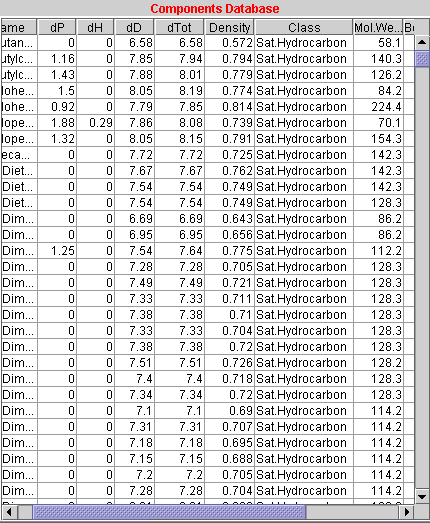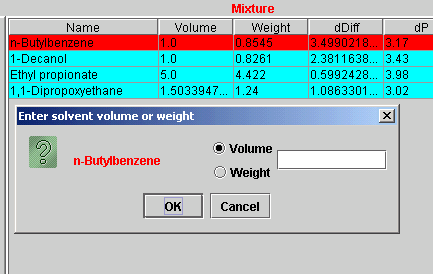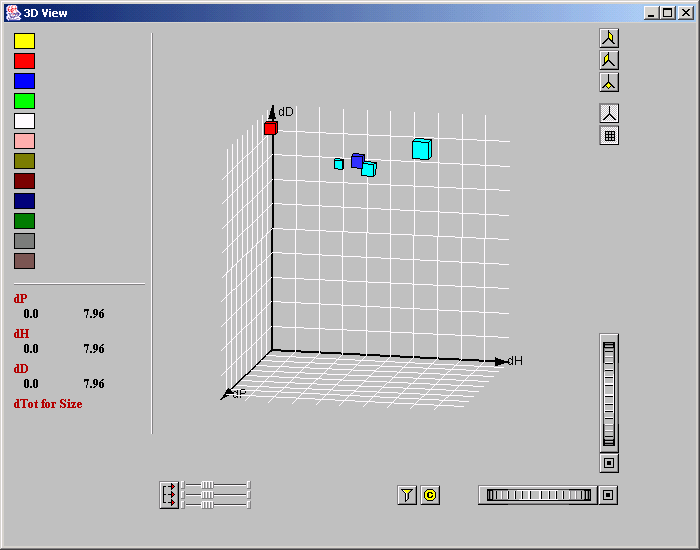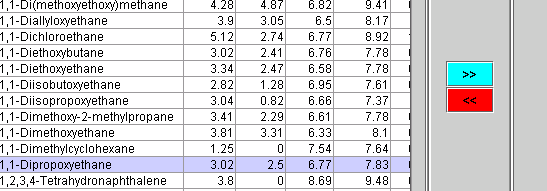Computer Chemistry Consultancy - XML4Pharma, Katzelbachweg 18, A-8052 Thal, Austria, info@CompChemCons.com
The SolventMixer Application
Other software: calculation / prediction of solubility parameters
Introduction
The Solvent Mixer is an application that calculates the properties of a mixture of solvents. Solvents can be choosen from a dataset (which is extensible) with over 700 compounds. The application concentrates on the calculation of the Hansen/Hoy solubility parameter of the mixture. It calculates the average (3-dimensional) Solubility parameter of the mixture and marks those solvents/compounds that are likely not to be soluble in the mixture. The latter is done on basis of the difference in solubility parameter between that of the added solvent and the average one of the mixture. The criterium (allowable difference in solubility parameter) to decide compatibility can be adjusted by the user. The Solvent Mixer is an excellent application to derive average solubility properties of a mixture, and to predict whether an added material will be compatible with the solvent mixture.
Details
The main frame of the applications shows 2 tables.
The left table is filled with solvents from the dataset upon startup of the application.
 At the moment the dataset contains over 700 solvents and materials, with their Hansen or Hoy (3-dimensional) solubility parameters,
density, chemical class, molecular weight, boiling point, vapour pressure, and relative evaporation rate (n-butylacetate=100).
At the moment the dataset contains over 700 solvents and materials, with their Hansen or Hoy (3-dimensional) solubility parameters,
density, chemical class, molecular weight, boiling point, vapour pressure, and relative evaporation rate (n-butylacetate=100).
Primary and secondary sorting of the table can be achieved by clicking on the column headers.
 When adding a component to the mixture, the user can choose by adding the amount as volume or as weight.
The non-chosen one is then calculated using the given density.
When a component has been added to the mixture, its amount can still be changed by right-clicking on the corresponding row in the right table.
A component can also be removed from the mixture by selecting it and clicking the
When adding a component to the mixture, the user can choose by adding the amount as volume or as weight.
The non-chosen one is then calculated using the given density.
When a component has been added to the mixture, its amount can still be changed by right-clicking on the corresponding row in the right table.
A component can also be removed from the mixture by selecting it and clicking the ![]() button.
After each addition to or change in the composition of the mixture, the average properties are automatically recalculated.
After each change, also the compatibility of each of the components is automatically recalculated.
button.
After each addition to or change in the composition of the mixture, the average properties are automatically recalculated.
After each change, also the compatibility of each of the components is automatically recalculated.
 The decision whether a component is compatible with the mixture is taken from the absolute difference in solubility parameter between the component
and the average solubility parameter of the mixture (absolute distance in 3-dimensional space):
when the difference is larger than a threshold value (given by the user by setting the slider),
the component is regarded as non-miscible, and the corresponding row is colored in red in the mixture table
(choice of color can be changed). Components that are regarded miscible are colored in light-blue (changeable).
The decision whether a component is compatible with the mixture is taken from the absolute difference in solubility parameter between the component
and the average solubility parameter of the mixture (absolute distance in 3-dimensional space):
when the difference is larger than a threshold value (given by the user by setting the slider),
the component is regarded as non-miscible, and the corresponding row is colored in red in the mixture table
(choice of color can be changed). Components that are regarded miscible are colored in light-blue (changeable).
 A 3-dimensional plot, showing the Hansen parameters of the components in the mixture in their 3-dimensional space, is also provided.
Also here, non-compatible components are colored in red, and compatible solvents in light-blue. The 3-D plot is fully rotatble, one can zoom in and out, a raster can be shown.
Clicking on a data point in the 3-dimensional plot immediately gives all the available data of that component.
A 3-dimensional plot, showing the Hansen parameters of the components in the mixture in their 3-dimensional space, is also provided.
Also here, non-compatible components are colored in red, and compatible solvents in light-blue. The 3-D plot is fully rotatble, one can zoom in and out, a raster can be shown.
Clicking on a data point in the 3-dimensional plot immediately gives all the available data of that component.
A full report, which can be printed out, is generated when the user clicks the "Show Mixture Properties" button. The report lists all the components of the mixture,
their volume and weight contributions, their solubility parameters. The non-compatible components are highlighted in red.
Moreover, the average properties of the mixture, solubility parameters and density are also listed.
Two calculation modes
The application can be run in two calculation modes.
In the first mode, named the non-exclusion mode, it is assumed that the mixture remains homogeneous (no phase separation). So, when a compound in the mixture is highlighted as being non-compatible, it is assumed that it is on the edge of being phase-separated or precipitated. The overall properties of the mixture are still calculated including this compound (average solubility parameters, density etc.). This mode is preferred when the user wants to know which of the compounds in the mixture are likely to phase-separate or precipitate first.
The second mode is named exclusion-mode. In this mode, the less compatible compound in the mixture is determined, and if its solubility parameters deviate more than the threshold from the average solubility parameters, it is assumed to phase-separate or precipitate. At that moment, the average properties of the mixture are recalculated, excluding the non-compatible compound. This leads to a shift in average solubility parameters, which may have consequences for other compounds in the mixture. If such a phase-separation is indicated, the average properties calculated are always those of the phase with the largest volume. This mode is preferred when the user wants to simulate phase-separation, and wants to obtain the properties of the main phase after phase-separation or precipation.
At all times, one can switch between between the two modes with one click on a button. The new properties are recalculated immediately, and the panels and the 3-D plot are updated automatically.
Options
Hoy or Hansen
The application can either be delivered with a dataset of Hoy Solubility Parameters (over 700 compounds) or with a dataset of Hansen Solubility Parameters (over 800 compounds).
The values in these data sets differ slightly.
Using the dataset with Hoy Solubility parameters is ideal in the case you want to use the application with our application to calculate solubility parameters
for materials where no experimental or literature data are available.
If however, you are already using Hansen solubility parameters in your company, we advise you to opt for the second dataset.
Note that the dataset come as an XML file, which means you can very easily add new compounds to the dataset.
If you have already a compounds database with solubility parameters in your company, we will be glad to interface it with the software.
(cal/cm3)1/2 units or (J/cm3)1/2 units
You can also choose whether to get the software (and the corresponding dataset) using (cal/cm3)1/2 units, or to get it using (J/cm3)1/2 (i.e. (MPa)1/2) units. Please indicate your choice when ordering the software.
Pricing
A. Web version (suitable for deployment on your company's intranet)
In case several users want to use the software, we advise you to acquire the web version of the software (Java applet).The basic applet, together with the extensible dataset (Hoy or Hansen) comes at a price of €1500 (US$2200).
The license allows you to deploy the applet and dataset on a webserver(*), without limitation at all for the
number of users. This essentially means that the applet can be used corporation wide.
For interfacing with already existing corporate databases, ask us for an offer.
(*) Note: Only in the case of an intranet.
B. Single PC version
If you need the application for just one user, you can purchase a single-user license at the price of €800 (US$1150).
The functionality is identical to that of the web server version, but you cannot deploy the application on a web server. The license than allows you to install the software on a single PC or workstation.
